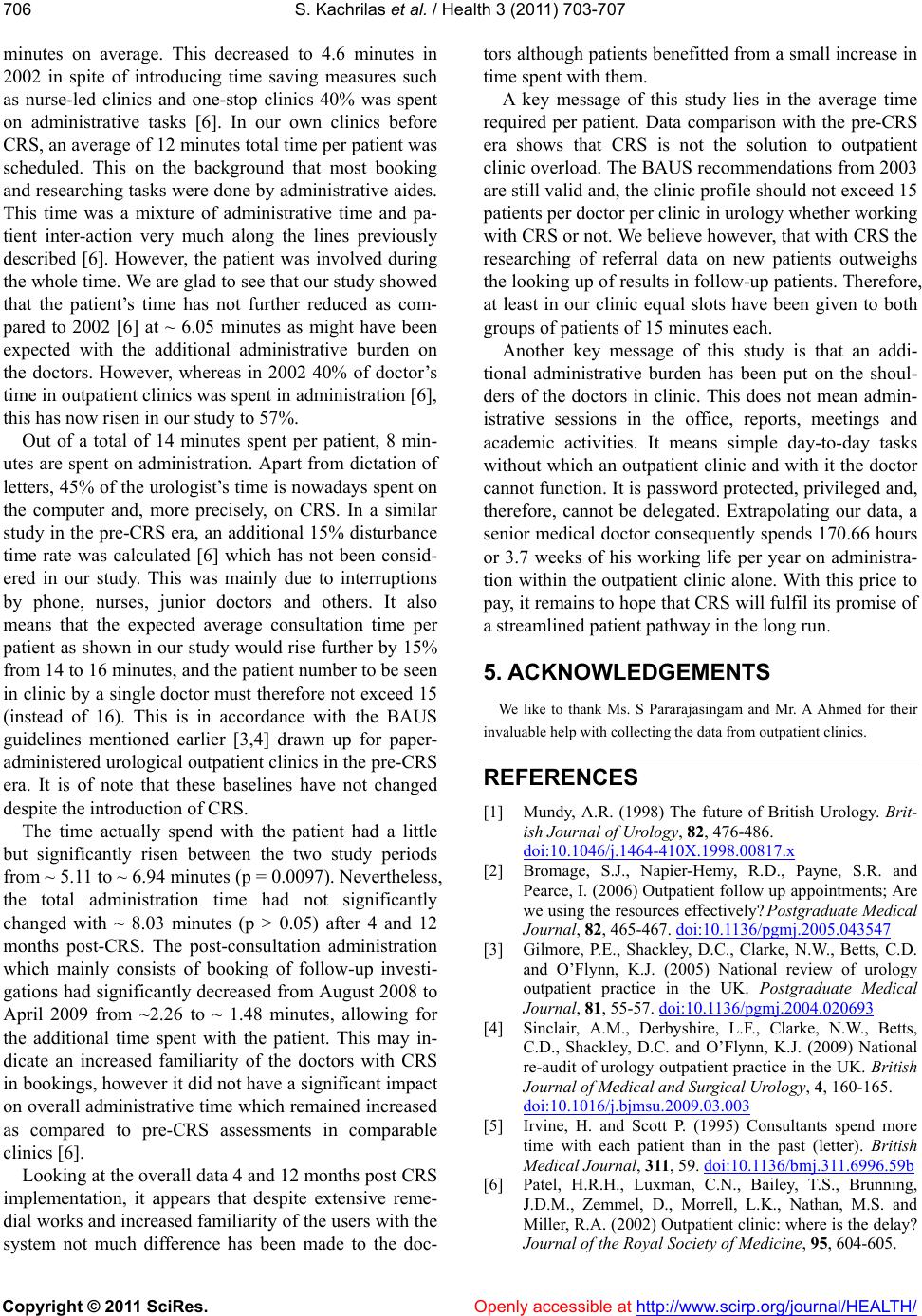
S. Kachrilas et al. / Health 3 (2011) 703-707
Copyright © 2011 SciRes. Openly accessible at http://www.scirp.org/journal/HEALTH/
706
minutes on average. This decreased to 4.6 minutes in
2002 in spite of introducing time saving measures such
as nurse-led clinics and one-stop clinics 40% was spent
on administrative tasks [6]. In our own clinics before
CRS, an average of 12 minutes total time per patient was
scheduled. This on the background that most booking
and researching tasks were done by administrative aides.
This time was a mixture of administrative time and pa-
tient inter-action very much along the lines previously
described [6]. However, the patient was involved during
the whole time. We are glad to see that our study showed
that the patient’s time has not further reduced as com-
pared to 2002 [6] at ~ 6.05 minutes as might have been
expected with the additional administrative burden on
the doctors. However, whereas in 2002 40% of doctor’s
time in outpatient clinics was spent in administration [6],
this has now risen in our study to 57%.
Out of a total of 14 minutes spent per patient, 8 min-
utes are spent on administration. Apart from dictation of
letters, 45% of the urologist’s time is nowadays spent on
the computer and, more precisely, on CRS. In a similar
study in the pre-CRS era, an additional 15% disturbance
time rate was calculated [6] which has not been consid-
ered in our study. This was mainly due to interruptions
by phone, nurses, junior doctors and others. It also
means that the expected average consultation time per
patient as shown in our study would rise further by 15%
from 14 to 16 minutes, and the patient number to be seen
in clinic by a single doctor must therefore not exceed 15
(instead of 16). This is in accordance with the BAUS
guidelines mentioned earlier [3,4] drawn up for paper-
administered urological outpatient clinics in the pre-CRS
era. It is of note that these baselines have not changed
despite the introduction of CRS.
The time actually spend with the patient had a little
but significantly risen between the two study periods
from ~ 5.11 to ~ 6.94 minutes (p = 0.0097). Nevertheless,
the total administration time had not significantly
changed with ~ 8.03 minutes (p > 0.05) after 4 and 12
months post-CRS. The post-consultation administration
which mainly consists of booking of follow-up investi-
gations had significantly decreased from August 2008 to
April 2009 from ~2.26 to ~ 1.48 minutes, allowing for
the additional time spent with the patient. This may in-
dicate an increased familiarity of the doctors with CRS
in bookings, however it did not have a significant impact
on overall administrative time which remained increased
as compared to pre-CRS assessments in comparable
clinics [6].
Looking at the overall data 4 and 12 months post CRS
implementation, it appears that despite extensive reme-
dial works and increased familiarity of the users with the
system not much difference has been made to the doc-
tors although patients benefitted from a small increase in
time spent with them.
A key message of this study lies in the average time
required per patient. Data comparison with the pre-CRS
era shows that CRS is not the solution to outpatient
clinic overload. The BAUS recommendations from 2003
are still valid and, the clinic profile should not exceed 15
patients per doctor per clinic in urology whether working
with CRS or not. We believe however, that with CRS the
researching of referral data on new patients outweighs
the looking up of results in follow-up patients. Therefore,
at least in our clinic equal slots have been given to both
groups of patients of 15 minutes each.
Another key message of this study is that an addi-
tional administrative burden has been put on the shoul-
ders of the doctors in clinic. This does not mean admin-
istrative sessions in the office, reports, meetings and
academic activities. It means simple day-to-day tasks
without which an outpatient clinic and with it the doctor
cannot function. It is password protected, privileged and,
therefore, cannot be delegated. Extrapolating our data, a
senior medical doctor consequently spends 170.66 hours
or 3.7 weeks of his working life per year on administra-
tion within the outpatient clinic alone. With this price to
pay, it remains to hope that CRS will fulfil its promise of
a streamlined patient pathway in the long run.
5. ACKNOWLEDGEMENTS
We like to thank Ms. S Pararajasingam and Mr. A Ahmed for their
invaluable help with collecting the data from outpatient clinics.
REFERENCES
[1] Mundy, A.R. (1998) The future of British Urology. Brit-
ish Journal of Urology, 82, 476-486.
doi:10.1046/j.1464-410X.1998.00817.x
[2] Bromage, S.J., Napier-Hemy, R.D., Payne, S.R. and
Pearce, I. (2006) Outpatient follow up appointments; Are
we using the resources effectively? Postgraduate Medical
Journal, 82, 465-467. doi:10.1136/pgmj.2005.043547
[3] Gilmore, P.E., Shackley, D.C., Clarke, N.W., Betts, C.D.
and O’Flynn, K.J. (2005) National review of urology
outpatient practice in the UK. Postgraduate Medical
Journal, 81, 55-57. doi:10.1136/pgmj.2004.020693
[4] Sinclair, A.M., Derbyshire, L.F., Clarke, N.W., Betts,
C.D., Shackley, D.C. and O’Flynn, K.J. (2009) National
re-audit of urology outpatient practice in the UK. British
Journal of Medical and Surgical Urology, 4, 160-165.
doi:10.1016/j.bjmsu.2009.03.003
[5] Irvine, H. and Scott P. (1995) Consultants spend more
time with each patient than in the past (letter). British
Medical Journal, 311, 59. doi:10.1136/bmj.311.6996.59b
[6] Patel, H.R.H., Luxman, C.N., Bailey, T.S., Brunning,
J.D.M., Zemmel, D., Morrell, L.K., Nathan, M.S. and
Miller, R.A. (2002) Outpatient clinic: where is the delay?
Journal of the Royal Society of Medicine, 95, 604-605.